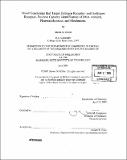Novel genotoxins that target estrogen receptor- and androgen receptor- positive cancers : identification of DNA adducts, pharmacokinetics, and mechanism
Author(s)
Hillier, Shawn M. (Shawn Matthew)
DownloadFull printable version (17.36Mb)
Other Contributors
Massachusetts Institute of Technology. Dept. of Chemistry.
Advisor
John M. Essigmann.
Terms of use
Metadata
Show full item recordAbstract
We have designed and synthesized novel molecules capable of selectively killing tumor cells that aberrantly express steroid hormone receptors. Many human breast cancers express high levels of the estrogen receptor (ER), and most prostate cancers express the androgen receptor (AR). We reasoned that the potential genotoxic effect of DNA adducts would be increased in target cells if these adducts were camouflaged by their association with receptor proteins. This association could shield the DNA adducts from repair proteins and thus increase the toxicity towards a tumor cell. Furthermore, these hormone receptors are transcription factors and an interaction between the protein and the DNA adduct could disrupt cellular signaling events, thus leading to further toxicity. We have synthesized bifunctional agents that contain an aniline mustard linked to ligands for tumor specific hormone receptors. To target ER(+) breast cancers, an aniline mustard was linked to estradiol at the 7[alpha] position (E2-7[alpha]), and to target AR(+) prostate cancer, the aniline mustard was linked to estradien-3-one at the 11[beta] position (11[beta]). Competitive binding experiments show that E2-7[alpha] and 11[beta] compete well with the natural ligands for the ER and AR, respectively. Clonal survival studies have shown that hormone receptor expressing malignant cell lines are more sensitive to our compounds than a corresponding receptor deficient line. [¹⁴C]-E2-7[alpha] and [¹⁴C]- 11[beta] have been formulated in Cremophor-EL and exhibit good bioavailability and stability when injected into mice intraperitoneally. E2-7[alpha] inhibits the growth of ER(+) HeLa cells and 11[beta] inhibits the growth of AR(+) LNCaP cells, both in xenograft mouse models. (cont.) The compounds are well tolerated by mice after the therapeutic regimens. Stable DNA adducts have been isolated and detected by electrospray mass spectrometry and accelerator mass spectrometry has provided us with a means of quantifying the number of DNA adducts formed in vivo. E2-7[alpha] DNA adducts are repaired, in part, by nucleotide excision repair but the adducts persist longer in ER(+) cells than in ER(-) ones. Melphalan adducts, however, are repaired with equal rates in both cell lines. This result provides evidence in support of the repair shielding hypothesis and suggests that it may be a contributing mechanism to the increased toxicity observed for the ER(+) cell line in the clonal survival study.
Description
Thesis (Ph. D.)--Massachusetts Institute of Technology, Dept. of Chemistry, 2005. Vita. Includes bibliographical references.
Date issued
2005Department
Massachusetts Institute of Technology. Department of ChemistryPublisher
Massachusetts Institute of Technology
Keywords
Chemistry.